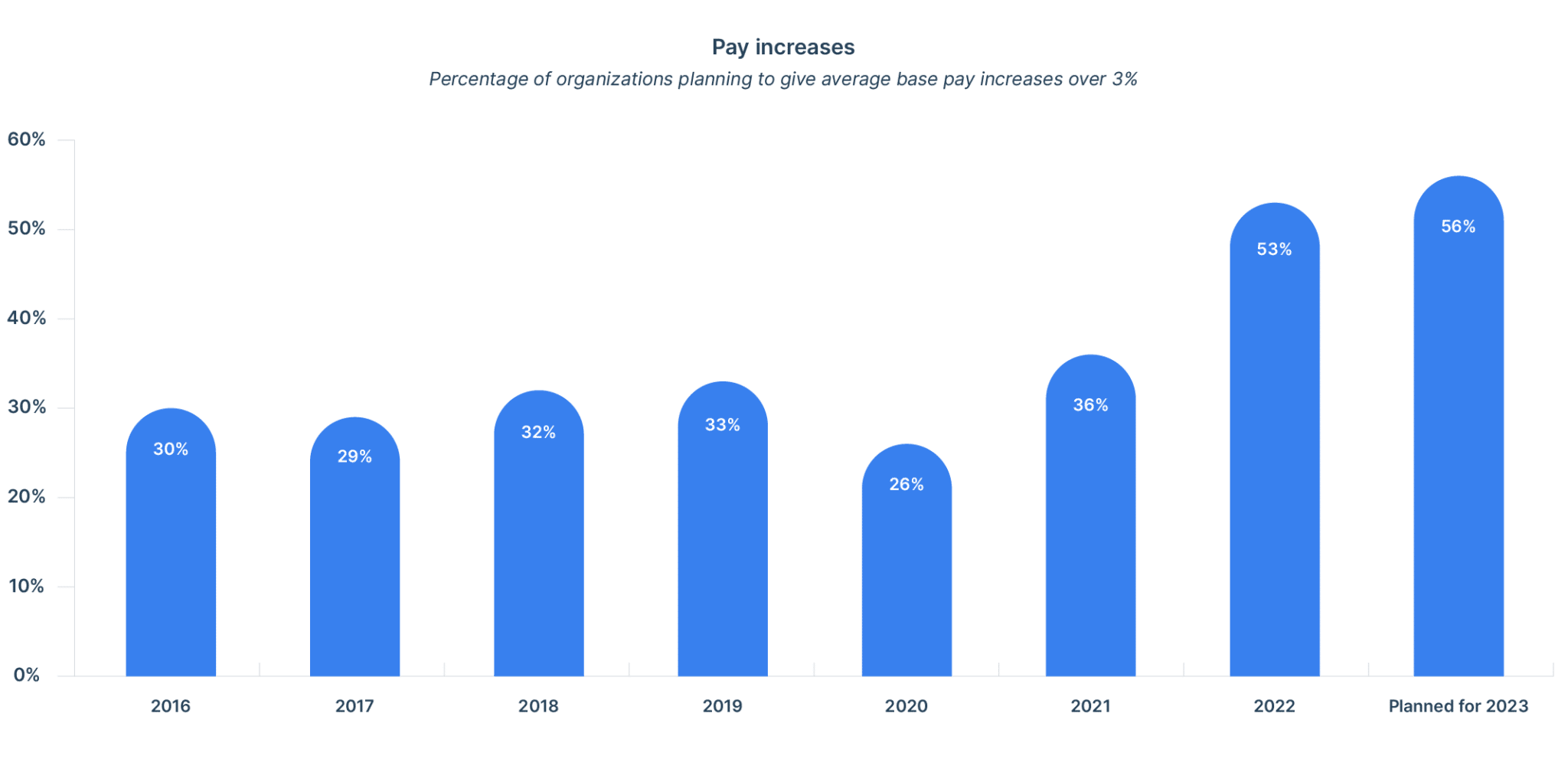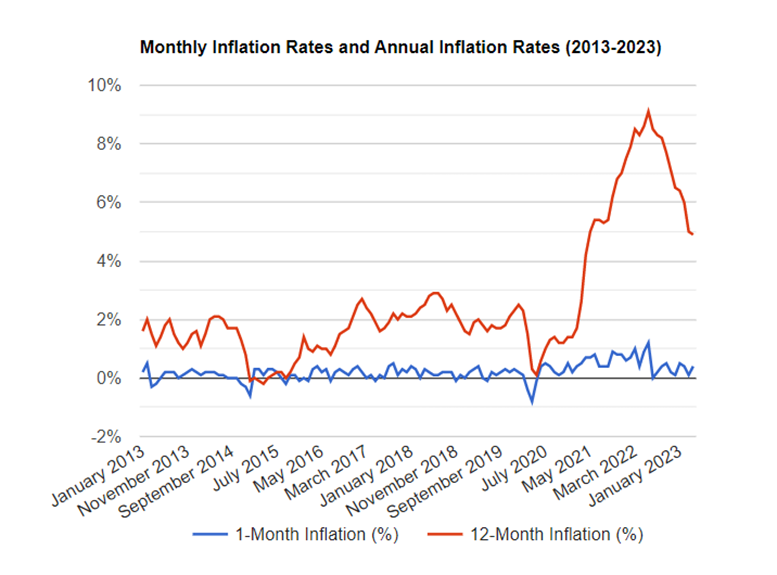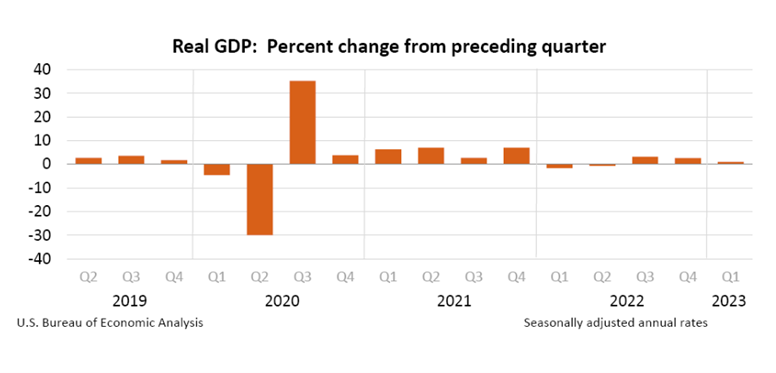The last few years have been challenging for compensation management professionals. The combination of high inflation, increased competition for labor, and economic uncertainty makes it difficult to know what to budget for pay increases.
To help compensation professionals and HR leaders with pay increase planning, Payscale runs an annual mid-year survey asking organizations what they gave for pay increases this year and what they are planning to budget for pay increases next year. This information may be particularly important given today’s labor market and all the factors that are contributing to economic volatility.
The survey is open now for participation through the end of June.
The data will be provided in a report at the end of July.
Pay increases have been higher than average
For years following the Great Recession of 2007–2008, the average base pay increase had been around 3 percent. However, 3 percent has not been the standard base pay increase for the past two years.
In 2022, organizations responded to high inflation and the Great Resignation with higher pay increases — in the 4–5 percent range, on average. According to Payscale’s 2023 Compensation Best Practices Report fielded in late 2022, this trend looked to continue into 2023 for most organizations.

However, at the time, only 80 percent of organizations said they were planning to give pay increases at all, with another 15 percent of organizations remaining undecided.
But a lot has changed since then.
Inflation is dropping but is still high
Inflation began to soar in 2021, reaching a high of 9.1 percent in June 2021 for the United States and double digits in Europe. However, inflation has been dropping over the last year. In the U.S., it has dropped to 4.9 percent according to the most recent report from April 2023 and is down considerably YOY from 8.3 percent in April 2022. However, it is still considerably higher than the target inflation rate of 2 percent. 
Inflation matters to compensation professionals because it impacts the value that an employee’s paycheck has in managing everyday life. High inflation is particularly hard on low-wage earners, who may be more driven to seek higher-paying opportunities if they can’t make ends meet on their current income. However, all employees are aware when pay increases don’t keep pace with inflation and can feel the impact that has on their earnings. This makes pay communications around pay increases especially important, especially as inflation is expected to remain at elevated levels through this year and into the next.
Inflation could prove further difficult to control if war in Europe intensifies, exacerbating supply shortages, or if the labor market reheats.
The near-future economy is uncertain
The market has been unpredictable since the pandemic, but economic uncertainty has been growing over the past year and has really accelerated in the past few months. Many experts are predicting that a recession is just on the horizon.
Typically, when a recession is predicted, employers are more conservative with pay increases. However, the current economic climate is unusual. Predictions that a recession is coming stem from central banks around the world raising interest rates to combat inflation, but other economic indicators that normally predict a recession have not been in alignment. Consumer spending remained strong in 2022, and although GDP growth has weakened according to early 2023 reports, it has remained positive overall.

The odds of a recession also vary by geography. According to the World Economic Forum, most chief economists expect moderate to strong growth in the Middle East, North Africa, and South Asia, and weakened growth in the United States and Europe.
The labor market is strong
The labor force participation rate is still below pre-pandemic levels and unemployment also remains low. In fact, unemployment dropped to 3.4 percent in the United States, which is well below the average of 5.72 percent and also below where unemployment was before the start of the pandemic (3.5 percent). Unemployment is 6.0 percent in Europe, which is also the lowest it has been in decades.
Low unemployment has persisted in spite of layoffs, which have not managed to turn the labor market in favor of employers. Quits rates also remain higher than pre-pandemic numbers. Although job openings and hires have fallen from Great Resignation highs, the competition for talent still outstrips pre-pandemic levels. In other words, we are still in a fierce competition for talent, which means that salary offers are likely to remain elevated.

Wage growth is high
The combination of high inflation and a strong labor market continues to drive up wage growth. This puts pressure on organizations to raise wages to keep salaries competitive. However, raising wages can exacerbate inflation and drive wage growth up even further.
According to the Payscale Index, wage growth has increased 7.5 percent year over year as of April 2023. The Payscale Index is a free resource that tracks quarterly changes in total cash compensation for full-time, private industry employees in 19 job categories, three company sizes, and 15 industries across 32 major Metropolitan Statistical Areas (MSAs) in the United States. Wage growth is currently highest in Florida (over 7 percent) and lowest in San Jose and San Francisco, where it is 3.8 percent and 4.0 percent respectively.

Inflation is one thing, but when pay increases do not match wage growth, organizations are at an even higher risk for turnover. Right now, if pay increases are low, employees might earn considerably more by leaving their organization than they would by staying.
In addition, pay transparency legislation is driving organizations to publish pay ranges in job ads, which may entice unhappy employees to apply to positions where they know they can earn more. However, pay transparency can also help to keep salary negotiations in check, which could rein in runaway wage growth if employed ubiquitously and communicated relentlessly.
Payscale tracks such legislation through our free pay transparency legislation tracker.
Preparing your budget for pay increases
So, what should you budget for 2024 pay increases?
That is what Payscale’s Salary Budget Survey (SBS) seeks to answer. The SBS is an annual survey that provides up-to-date information on how companies are increasing base salaries and adjusting salary structures for the current year as well as what they are budgeting for the next year.
The survey can take up to an hour to complete depending on how prepared you are to answer the questions. The time can be shortened considerably by having information related to salary budget planning already gathered and at your disposal.
Information you should have at hand includes:
- The total number of full-time employees (FTEs) in your organization
- Total revenue (calculated in USD regardless of your location)
- Whether your salary budget will increase, decrease, or remain the same in 2024 compared to 2023
- The primary reason your salary budget will increase or decrease respective to your previous answer
- The percentage of employees that received a base salary increase in 2023 for exempt, nonexempt, management, and executive positions — as well as what was budgeted for 2023 and planned for 2024 (these are separate questions repeated for different locations)
- Your actual and budgeted pay increases expressed as a percentage (decimals allowed)
Answers are collected for the following countries and will be included in the report, provided that we receive enough answers to calculate averages anonymously:
- United States
- Canada
- Australia
- Brazil
- China
- Finland
- France
- Germany
- India
- Ireland
- Japan
- Mexico
- Netherlands
- New Zealand
- Poland
- Singapore
- South Africa
- South Korea
- Spain
- Sweden
- United Kingdom
The Salary Budget Survey for 2023/2024 is open now through the end of June.
The data is aggregated in June and a report is released at the end of July and promoted in August. The final report is segmented by industry, country, region, company size, and more to provide a valuable point of reference to compensation managers and HR professionals engaged in budget planning for pay increases.















